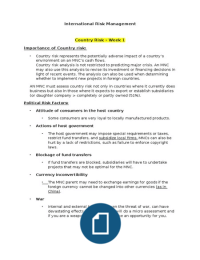International Risk Management
Country Risk - Week 1
Importance of Country risk:
• Country risk represents the potentially adverse impact of a country’s
environment on an MNC’s cash flows.
Country risk analysis is not restricted to predicting major crisis. An MNC
may also use this analysis to revise its investment or financing decisions in
light of recent events. The analysis can also be used when determining
whether to implement new projects in foreign countries.
AN MNC must assess country risk not only in countries where it currently does
business but also in those where it expects to export or establish subsidiaries
(or daughter company > completely or partly owned (51%).
Political Risk Factors:
• Attitude of consumers in the host country
• Some consumers are very loyal to locally manufactured products.
• Actions of host government
• The host government may impose special requirements or taxes,
restrict fund transfers, and subsidize local firms. MNCs can also be
hurt by a lack of restrictions, such as failure to enforce copyright
laws.
• Blockage of fund transfers
• If fund transfers are blocked, subsidiaries will have to undertake
projects that may not be optimal for the MNC.
• Currency inconvertibility
• The MNC parent may need to exchange earnings for goods if the
foreign currency cannot be changed into other currencies (as in
China).
• War
• Internal and external battles, or even the threat of war, can have
devastating effects. However, if you will do a micro assessment and
if you are a weapon seller, this would be an opportunity for you.
,• Bureaucracy
• Bureaucracy can complicate businesses. Bureaucracy goes hand in
hand with corruption. > You have to fill in many forms and this cost
a lot of time. Time costs money as well.
• Corruption
• Corruption can increase the cost of conducting business or reduce
revenue. For example, an MNC may lose revenue because a
government contract is awarded to a local firm that paid off a
government official.
• Financial Risk Factors
• Indicators of economic growth
- The current and potential state of a country’s economy is important
since a recession can severely reduce demand.
- A country’s economic growth is dependent on several financial
factors - interest rates (higher interest rates slow growth), exchange rates
(can influence demand for the country’s exports), inflation (can affect
consumers’ purchasing power), etc.
• Types of Country Risk Assessment
• A macroassessment of country risk is an overall risk assessment of a
country without considering the MNC’s business. - This type of risk is
convenient in that it remains the same for a given country, regardless of
the firm or industry of concern.
• A microassessment of country risk is the risk assessment of a country
with respect to the MNC’s type of business. - This is needed to determine
how the country risk relates to the specific MNC.
• The overall assessment thus consists of macropolitical risk,
macrofinancial risk, micropolitical risk, and microfinancial risk.
• Techniques of Assessing Country Risk
• Once a firm identifies all the macro- and micro factors that deserve
consideration in the country risk assessment, it may which to implement a
system for evaluating these factors and determining a country risk rating.
> Various techniques are shown below:
• The checklist approach involves rating and weighting all the macro and
micro political and financial factors to derive an overall assessment of
country risk.
• The Delphi technique involves collecting various independent opinions
and then averaging and measuring the dispersion of those opinions.
, • Quantitative analysis techniques like regression analysis can be applied
to historical data to assess the sensitivity of the business to various risk
factors.
• Inspection visits involve traveling to a country and meeting with
government officials, firm executives, and consumers to clarify
uncertainties.
Often, firms use a variety of techniques for making country risk
assessments.
For example, they may use the checklist approach to develop an overall
country risk rating, and some of the other techniques to assign ratings to
the factors.
• The checklist approach involves: > page 71 for an example
• 1. Assigning values and weights to political and financial risk factors,
• 2. Multiplying the factor values with their weights, and summing up
to give the political and
• financial risk ratings,
• 3. Assigning weights to the risk ratings, and
• 4. Multiplying the ratings with their weights, and summing up to give
the country risk rating.
• Once the political and financial ratings are determined, the overall country
risk can be derived (afstammen / afgeleid zijn van), given the weights
assigned to political and financial risk.
• Comparing Risk Ratings Among Countries
• One approach to comparing political and financial ratings among countries
is the foreign investment risk matrix (FIRM ).
• The matrix displays financial (or economic) and political risk by intervals
ranging from “poor” to “good.”
• Each country can be positioned on the matrix based on its political and
financial ratings. Many industrialized countries (Netherlands) have high
ratings, indicating low risk.
• Incorporating (opnemen) Country Risk in Capital Budgeting
• If the risk rating of a country is acceptable, the projects related to that
country deserve further consideration.
• Country risk can be incorporated into the capital budgeting analysis of a
proposed project either by adjusting the discount rate or by adjusting the
estimated cash flows.
• Adjustment of the discount rate
• The lower the country risk rating, the higher the perceived
risk, the higher the discount rate that should be applied to the
project’s cash flows.





